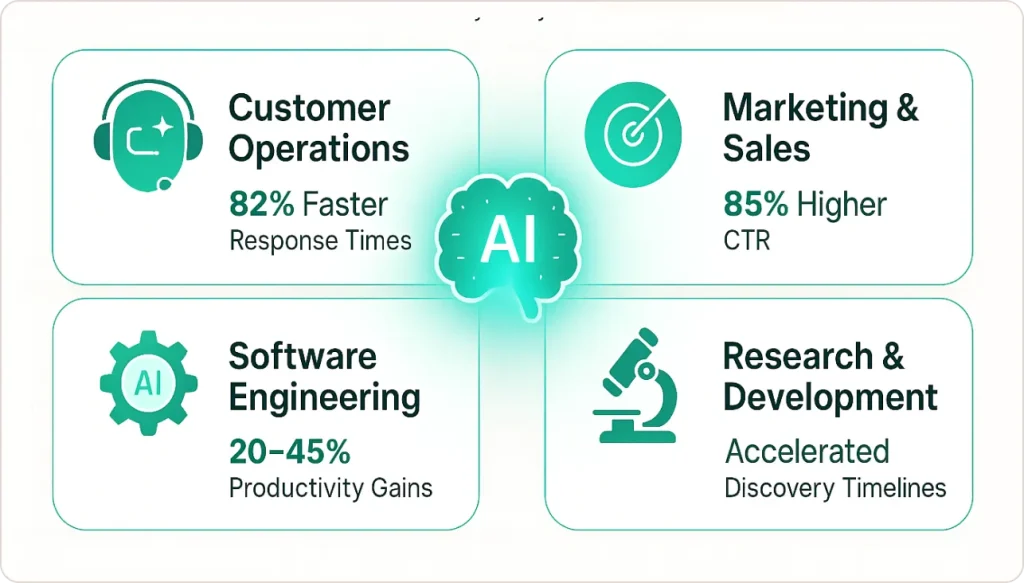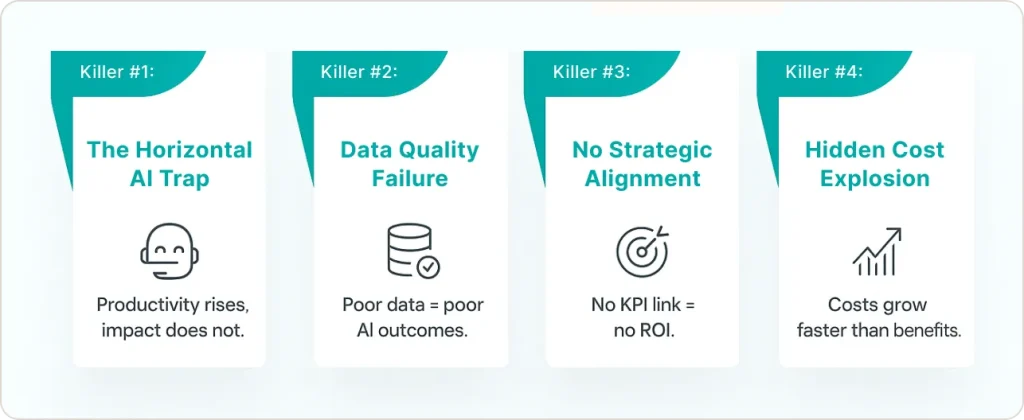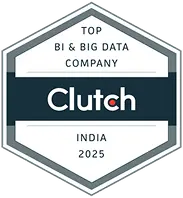TL;DR:
- 30% of GenAI projects fail after POC – Gartner identifies poor data quality and unclear business value as primary killers
- What is GenAI’s economic potential? McKinsey estimates $2.6-4.4 trillion annual value, but only 6% of companies capture significant returns
- Benefits of generative AI concentrate in four functions: customer operations (82% faster response times), marketing/sales (85% higher CTR), software engineering (45% productivity gains), and R&D
- The horizontal vs. vertical distinction matters: Generic ChatGPT makes individuals 15% faster; vertical AI transforms business outcomes by 3-4x
- Advantage industries see 20%+ digital budget allocation: Healthcare, financial services, and manufacturing lead generative AI transformation with measurable ROI
- Critical insight for generative AI strategists: Clean proprietary data separates $180K failures from 4x ROI successes
Why Most GenAI Investments Deliver Zero Business Impact
A mid-market manufacturing company recently invested $2.1 million in generative AI initiatives. The CFO deployed ChatGPT Enterprise across the organization, expecting transformation. Six months later, the measurable impact on revenue, operating costs, or key performance indicators? Zero.
I asked him one question: “Can your AI access your proprietary customer data, production schedules, or quality metrics?”
Silence.
His team had given employees a faster way to write emails. That’s it. No connection to the manufacturing data that could actually transform operations. No integration with the supply chain systems that drive margins. No access to the customer insights that improve retention.
This conversation repeats weekly in my consulting practice. Gartner predicts that 30% of generative AI projects will be abandoned after proof of concept by the end of 2025, primarily due to poor data quality, escalating costs, and unclear business value. Yet McKinsey estimates generative AI could add $2.6 trillion to $4.4 trillion annually to the global economy.
The gap between potential and reality isn’t about technology, it’s about implementation strategy. Let me show you what I’ve learned separating winners from expensive failures.
Quick Answer
While generative AI promises transformative business impact, research shows that 30% of projects will be abandoned after proof-of-concept by the end of 2025. This guide explains the key reasons for these failures like relying on generic horizontal AI and neglecting data preparation and shares a proven framework to achieve real ROI with vertical, data-integrated solutions and strategic implementation.

What Is GenAI? Understanding the Technology Behind Business Transformation
Before we dive into implementation, let’s clarify what GenAI is and why it differs from previous AI waves.
What is Generative AI?
Generative AI for business refers to artificial intelligence systems that create new content, text, code, images, and analysis rather than simply classifying or predicting from existing data. Unlike traditional AI that says “this customer will likely churn” (prediction), GenAI says “here’s a personalized retention offer for this customer based on their complete history” (generation).
How Can Generative AI Models Be Used in Business?
The practical applications I see working fall into four categories:
- Customer Intelligence: Analyzing complete customer histories to generate personalized responses and experiences
- Knowledge Synthesis: Extracting insights from vast internal documentation instantly
- Content & Code Generation: Creating marketing materials or software based on your specific context
- Decision Support: Generating scenario analyses using your proprietary business data
The key phrase in each? “Your specific context” and “your proprietary data.” Generic GenAI gives you generic results. Specialized GenAI integrated with your data gives you a competitive advantage.
The Benefits of Generative AI: Where 75% of Economic Value Concentrates
Here’s what surprised me most after analyzing dozens of implementations: 75% of generative AI’s economic value concentrates in just four business functions, according to McKinsey’s analysis of 63 use cases.

Customer Operations: The 82% Speed Improvement
I recently worked with a healthcare analytics client whose support team spent 11 minutes on average per customer inquiry. We deployed vertical AI integrated with their complete customer database, product documentation, and historical ticket resolution patterns.
Result? Response times dropped to 2 minutes—an 82% improvement mirroring Klarna’s results handling 2.3 million conversations monthly.
The critical difference: We didn’t deploy a generic chatbot. We built generative AI for businesses that understood their specific products, customer segments, and service history.
Benefits of generative AI in customer operations:
- 82% faster response times (11 min → 2 min)
- Equivalent work of 700 FTE agents for large-scale deployments
- Higher satisfaction scores through consistent, accurate responses
- 24/7 availability without quality degradation
Marketing & Sales: The 85% CTR Advantage
One of my retail clients was using ChatGPT to write blog posts slightly faster. I asked: “How is generative AI transformation actually changing your customer acquisition cost?”
They couldn’t answer. We pivoted.
We built a system analyzing their complete customer purchase history, campaign performance data, and competitive positioning. The AI-generated hyper-personalized email campaigns based on individual customer behavior patterns.
Bayer achieved similar results: its AI-generated ad copy delivered 85% higher click-through rates than human-written control groups because the system understood which messaging resonated with which customer segments.
Advantage industries seeing success: E-commerce, retail, B2B SaaS, and financial services where customer data volume enables sophisticated personalization.
Software Engineering: The 20-45% Reality Check
When developers tell me they’re 20% faster with GitHub Copilot, I believe them. When engineering leaders claim 45% productivity gains, I investigate further.
The 20% gains come from autocomplete and boilerplate generation—helpful but not transformative. The 45% gains come from specialized systems trained on the company’s specific codebase, architecture patterns, and testing frameworks.
How can generative AI models be used in business engineering:
- Understanding technical debt specific to your codebase
- Suggesting refactoring aligned with your architecture principles
- Generating tests based on your existing quality standards
- Automating documentation using your team’s conventions
Generic AI speeds up typing. Specialized AI transforms engineering velocity.
R&D: Accelerating Discovery Through Specialized Knowledge
In pharmaceuticals, I’ve seen GenAI models trained on molecular structures and clinical trial data significantly shorten drug discovery timelines. In manufacturing, models trained on physics simulations enable design solutions that weren’t previously possible.
The pattern: Advantage industries with complex domain knowledge and substantial proprietary research data see the biggest R&D benefits from generative AI transformation.
📌 KEY TAKEAWAY: The 75% value concentration in these four functions only materializes with vertical AI implementations integrated with proprietary data. Horizontal tools deliver marginal gains; vertical solutions drive transformation.
Why 80% Fail: The Four Implementation Killers I See Repeatedly
After watching both spectacular successes and expensive failures, I’ve identified four patterns that predict which path you’ll take:

Killer #1: The Horizontal AI Trap
What I see failing: Companies deploy ChatGPT Enterprise or generic copilots expecting business transformation. Employees write emails 15% faster, but customer acquisition cost doesn’t drop, product development doesn’t accelerate, and margins don’t improve.
The diagnostic question I ask every client: “If we removed this AI tool tomorrow, would your revenue, margin, or key operational KPIs change significantly?”
If the answer is no, you’re buying employee convenience, not generative AI transformation.
What is GenAI that actually transforms businesses? Vertical AI—specialized solutions tailored to your industry that integrate deeply with your proprietary data.
| Feature | Horizontal AI (Generic) | Vertical AI (Specialized) |
|---|---|---|
| Data Integration | None or minimal | Deep proprietary integration |
| Business Impact | Diffuse productivity gains | Measurable KPI improvement |
| Implementation Cost | $10-50K | $100K-500K |
| ROI Timeline | Unclear/never | 6-12 months |
| Competitive Advantage | None (everyone has it) | Significant (unique to you) |
See how vertical AI delivers measurable results in specific industries like CPG Analytics, where specialized solutions achieve 85%+ forecast accuracy compared to 60-70% with generic tools.
Killer #2: The $12.9M Data Quality Problem
A financial services client once asked me to implement GenAI for regulatory compliance reporting. I reviewed their data first: outdated policy documents, inconsistent formatting, no version control, gaps in their regulatory database.
I told them to stop. They didn’t listen.
Three months and $180K later, their system generated reports with fabricated citations and incorrect regulatory interpretations. Complete restart required.
Poor data quality costs companies an average of $12.9 million annually. Even advanced foundation models only perform as well as the data they’re trained on.
The data quality checklist I use with every client:
✅ Accuracy: Is your data verified and current?
✅ Completeness: Are there critical gaps in your datasets?
✅ Accessibility: Is data properly formatted and available?
✅ Governance: Do you have clear ownership, security, and compliance processes?
If you can’t check all four boxes, fix your data infrastructure before deploying generative AI for business.
Building this data foundation starts with comprehensive Data Analytics Services that establish governance frameworks, quality controls, and centralized data architecture before layering AI on top.
Killer #3: No Strategic Alignment = No ROI
I recently met with a company that had deployed five separate GenAI experiments across different departments. When I asked the CIO what specific business metrics these initiatives would improve, he couldn’t answer.
“We’re just experimenting to see what works,” he said.
That’s a $500K way to learn nothing actionable.
The three questions every generative AI strategist must answer before implementation:
- What specific business metric will this improve? (Revenue? Margin? Customer retention?)
- By how much? (Target: 20% cost reduction? 30% faster time-to-market?)
- Within what timeframe? (90 days for proof? 6 months for full ROI?)
If you can’t answer all three, you’re experimenting, not implementing.
Killer #4: The Hidden Cost Explosion
“The AI platform license is only $50K annually,” the vendor told my client. “It’s affordable.”
What they didn’t mention:
- $200K in high-performance computing infrastructure
- $150K annually for data governance and quality management
- $180K for specialized in-house expertise
- $100K+ for ongoing model maintenance and retraining
GenAI deployment costs range from $5 million to $20 million including upfront and recurring expenses.
What is GenAI’s true total cost of ownership?
Organizations achieving significant value commit more than 20% of their digital budgets to AI. They treat generative AI transformation as strategic business investment requiring fundamental organizational commitment, not a software installation.
The Workforce Transformation Nobody’s Discussing
Here’s the subtle long-term risk that should concern every executive: automating entry-level positions destroys your talent pipeline.
Generative AI excels at automating entry-level tasks that traditionally serve as training grounds for developing senior talent:
- Initial code drafting for junior developers
- Basic administrative tasks for operations roles
- Simple content writing for marketing positions
- Entry-level analysis for business intelligence teams
When you automate these training grounds, you eliminate the pathway for developing your next generation of senior leaders. This creates an “exponentially bad move” for long-term organizational health.
The data confirms the problem: In one 2024 survey, 77% of employees reported AI created more work (different kinds of work), not less. Organizations must manage augmentation and retraining, not just automation.
Strategic response: Successful companies redesign workflows for “Human + AI” collaboration rather than pursuing simple automation. They:
- Position AI to handle repetitive execution and data processing
- Focus human talent on quality oversight, strategic decision-making, and creative problem-solving
- Invest heavily in upskilling programs to maintain a viable talent pipeline
- Create new roles that leverage AI capabilities rather than compete with them
This isn’t just ethical responsibility—it’s a competitive necessity. Companies that destroy their talent pipelines face critical skill gaps within 3-5 years as senior employees retire or move on, leaving no experienced middle management to promote.
Battle-Tested Implementation Framework (The 6-Phase Approach)
After guiding dozens of implementations, here’s the framework I use with every client to avoid the 80% failure rate:

Phase 1: Strategic Assessment (Week 1-2)
I never start with technology. I start with pain points.
The questions I ask in initial client meetings:
- Where are you spending the most money on repetitive, data-rich processes?
- Which functions create competitive advantage when executed faster?
- What areas could benefit from personalization at scale?
- Do you have clean data for these functions?
Real example: A healthcare client said “We want AI for everything!” I asked: “Where do you spend the most time on repetitive work?” Answer: Clinical research reports that took analysts 6-8 hours each.
That became our focus. One use case. Clear pain point. Measurable outcome.
Phase 2: Vertical vs Horizontal Decision (Week 2-3)
How can generative AI models be used in business effectively? Only when they access proprietary data that creates competitive advantage.
For each potential use case, I evaluate:
| Decision Criteria | Vertical AI | Horizontal AI |
|---|---|---|
| Requires proprietary data? | ✅ Yes | ❌ No |
| Impacts core business metrics? | ✅ Yes | ❌ No |
| Measurable ROI within 6 months? | ✅ Yes | ❌ Maybe |
| Have data quality/infrastructure? | ✅ Yes | Not relevant |
If yes to all four: Vertical AI opportunity (high investment, high return)
If no to any: Consider horizontal tools (low investment, marginal return) or skip entirely
Phase 3: Data Readiness Validation (Week 3-4)
This phase saves millions. I audit:
Data Existence & Accessibility
- Does required data actually exist in usable format?
- Can we access it without 6-month IT projects?
Data Quality Standards
- Accuracy: Verified and current information?
- Completeness: No critical gaps in coverage?
- Consistency: Standardized across systems?
Governance & Compliance
- Clear data ownership and accountability?
- Security protocols for AI model access?
- Legal/compliance approval for data usage?
If any area fails validation, we stop and fix it before proceeding. Only 48% of AI projects make it into production, and inadequate data preparation is the primary killer.
Phase 4: Focused Pilot with Clear KPIs (Month 2-3)
I keep pilots ruthlessly focused:
Scope Definition
- One department or one specific use case only
- 2-3 measurable KPIs (not “improved productivity”)
- Baseline metrics established before launch
- Success criteria defined with executive sponsors
Example success criteria from my healthcare client: “Reduce clinical research report generation time by 70% (from 6-8 hours to under 2 hours) while maintaining quality scores above 4.5/5.0 within 60 days.”
Phase 5: Measure, Iterate, Decide (Month 3-4)
After pilot completion, I conduct rigorous ROI analysis:
Quantitative Assessment
- Actual results vs. baseline metrics
- Full cost calculation (development + infrastructure + ongoing)
- ROI calculation using real operational impact
The critical decision: Scale, pivot, or kill
I tell every client: Killing a $50K failed pilot is success. Scaling a failed pilot into a $500K disaster is failure.
Real outcome: My healthcare client achieved 75% time reduction (6-8 hours → 90 minutes), 4.2x ROI within 8 months, and 3x increase in client deliverable capacity. We scaled.
Phase 6: Strategic Scaling (Month 4+)
When pilots succeed, I scale methodically:
Expansion Strategy
- Phase 1: Adjacent departments with similar use cases
- Phase 2: Related functions with different requirements
- Phase 3: Enterprise-wide deployment with customization
Ongoing Optimization
- Continuous feedback collection and refinement
- Performance monitoring and quality assurance
- Governance policy establishment
- Change management and comprehensive training
Organizations achieving generative AI transformation move through this framework systematically, validating assumptions at each stage.
What Separates the 6% Achieving Significant Value
About 6% of organizations qualify as AI high performers—those attributing 5%+ EBIT impact to AI use. After studying both my successful clients and industry research, three strategic commitments separate winners from the rest:
1. Strategic Vertical Focus Over Horizontal Convenience
High performers don’t deploy ChatGPT company-wide hoping for transformation. They build specialized generative AI for business that integrates deeply with proprietary data.
What I see working: Custom models trained on 10+ years of customer data, product documentation, and operational metrics—not generic AI assistants.
2. Bold Investment Commitment (20%+ of Digital Budget)
High performers commit more than 20% of digital budgets to AI. They run four or more AI projects in production simultaneously, treating AI as strategic transformation requiring sustained investment.
Advantage industries leading this approach: Financial services, healthcare, manufacturing, and technology sectors where data volume and complexity create competitive moats.
3. Transformation Focus, Not Automation
The generative AI strategists I respect most aren’t automating existing processes—they’re redesigning workflows to embed AI into business operations fundamentally.
Example: Instead of “AI writes support responses faster,” they architect “AI analyzes complete customer context, generates personalized solutions, escalates complex cases to humans with full context, and learns from human corrections.”
That’s transformation, not automation.
Expert Perspective: The Reality Check Every Executive Needs
“After last year’s hype, executives are impatient to see returns on GenAI investments, yet organizations are struggling to prove and realize value,” according to Rita Sallam, Distinguished VP Analyst at Gartner.
This aligns perfectly with what I tell clients: Start focused, prove value quickly, then scale strategically. Organizations that try to “boil the ocean” with enterprise-wide deployments before proving ROI almost always fail.
Your Strategic Decision: How to Avoid the $2M Mistake
Generative AI represents a massive value opportunity. McKinsey estimates that generative AI could add the equivalent of $2.6 trillion to $4.4 trillion annually across industries. But potential and reality diverge sharply based on the implementation approach.
The 30% that fail deploy horizontal AI without data readiness, lack clear KPIs, and underestimate total costs. They get marginal productivity gains and expensive lessons.
The 6% that achieve significant value focus on vertical AI integrated with proprietary data, validate rigorously at each phase, establish measurable KPIs tied to business outcomes, and invest in comprehensive workforce transformation alongside technology deployment.
Next Steps: From Strategy to Action
Before investing in generative AI:
- Audit your data readiness: Assess current data quality, accessibility, and governance capabilities
- Identify vertical AI opportunities: Focus on business functions where proprietary data creates competitive advantage
- Establish clear success metrics: Define specific, measurable KPIs tied to revenue or operational performance
- Calculate realistic TCO: Include ongoing infrastructure, maintenance, and expertise costs
- Plan for workforce transformation: Design Human + AI workflows that preserve talent development pathways
Most importantly: resist pressure to “do AI” without clear business justification. The organizations I see achieving transformative results started with specific business problems, not technology solutions.
Your next decision determines whether you join the 6% capturing competitive advantage or the 30% learning expensive lessons.
Conclusion: Choose Your Implementation Path Wisely
After two years guiding companies through generative AI for business implementations, I’ve watched the pattern repeat: bold investment announcements followed by quiet abandonment as reality diverges from expectations.
The benefits of generative AI are real. Organizations achieving significant value report material cost decreases and revenue increases. But success isn’t about having the most sophisticated AI models—it’s about having the cleanest data, clearest business objectives, and most disciplined implementation approach.
I started this guide with a $2.1M failure story. Let me end with a success: my healthcare analytics client achieved 4.2x ROI within eight months by following this framework religiously. They validated data readiness before building, established clear KPIs tied to business outcomes, ran a focused 90-day pilot, and scaled methodically based on proven results.
The difference between these outcomes isn’t luck




